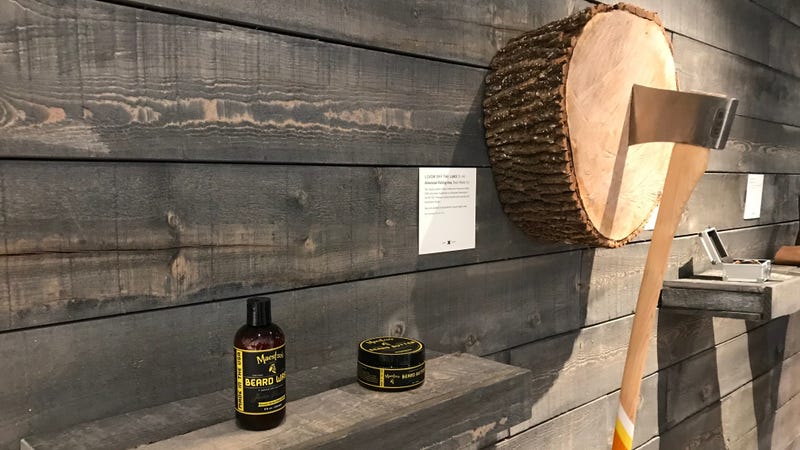
By most accounts, Justin Timberlake's latest musical offering, Man of the Woods, is bad—a half-hearted attempt at getting back to his roots while reconciling his new identity as a basic L.A. dad. Against all understandable odds, it debuted at the top of the Billboard 200—perhaps thanks to washed dads like Timberlake himself—but I'm pretty sure his three-day Man of the Woods pop-up experience in New York City had nothing to do with it.
The retail experience, curated and orchestrated by Bravado, was housed in an empty storefront in Soho during the first weekend of New York Fashion Week. The draw, of course, was likely not the Breeze off the Pond x Maestro Classic beard butter or the Wave x Warby Parker exclusive sunglasses available for purchase, but the Air Jordan 3 JTH, a collaboration between Timberlake and designer Tinker Hatfield. The shoes, which retail for $200 and are now only available for an exorbitant markup via various online resellers, made their debut on Timberlake's feet during his anemic Super Bowl Halftime performance and were the most exciting part of the entire spectacle.
Debuting the sneaker at the Super Bowl was a smart move by Nike (free advertising); making the shoes available at this highly unnecessary pop-up is the savviest decision Timberlake has made since the Trolls soundtrack. Traditional retail is dying and the retail "experience" is rising to take its place—Instagram-worthy events that are meant to sell some limited-edition goods, but hype most of all. If a consumer happens to leave an experience with a candle or a $50 Moleskine, consider it a bonus. For musicians like Timberlake, who might be quietly panicking at how the passage of time has rendered their shtick irrelevant and slightly passé, a heavily-curated pop-up shop built largely on the strength of a fashion sneaker is nothing more than a desperate grasp at relevancy—a way to prove that he's a cool dad who's still got it.
By the time I arrived Sunday morning, a small line had formed in the spitting rain. A girl behind me stood with a rolling suitcase, waiting patiently for the doors to open. She polled the line about whether or not there were any sneakers left. Word travelled down to us that the sneakers had sold out by Friday morning and people camped out Thursday night to get them. "I could budget at least $200," a man in front of me said with great certainty. We all agreed that anything over that price point would be an unnecessary extravagance and a waste of money. It was clear that no one in line was really there for Timberlake's music, though the two people I was next to agreed that 20/20 was some of his best work. The new album hadn't really moved the needle for anyone I spoke with.
Once I finally gained entry, I found myself in a space that was arranged sort of like a museum. A smiling attendant handed me a sheet with product images and prices; the Jordans, two $25 bandanas and a $250 Levis jacket were crossed out. What was left were other markers of Timberlake's supposed new persona: beard oil; a $350 Pendleton blanket; a $125 flask; and, laughably, a $350 axe that was sticking straight out of a tree trunk mounted to the wall. Each item in the store was associated with a song off the album. If you particularly enjoyed "Say Something," the track where JT enlists the help of Chris Stapelton for some country cred, there's a $50 bright yellow Moleskine notebook for your thoughts; if the opening number "Filthy" is more your speed, perhaps a $500 silver vest that screams MAN OF THE WOODS in safety orange on the lapel, crafted by streetwear designer Heron Preston, is more your speed. The vest really threw me for a loop; I puzzled for five minutes in front of it, wondering who precisely was the target audience? Perhaps just Timberlake himself—a washed dad trying to kick it with the children, but unsure of how to do so without seeming like a total goon.
Bravado, the Universal Music Group-owned merchandising company responsible for Timberlake's attempt at rebranding, also orchestrated Kanye's Yeezus pop-up and Justin Bieber's Purpose tour merch, the latter of which effectively changed the way artists think about and handle merchandising. "It set the tone that merch was becoming this other way to reach fans," Joe Perez, former creative director of DONDA, told Complex in 2016. "The pop-up store is another [fan] experience. People line up for blocks. It's crazy. Sometimes you'll see the same people there for three days in a row."
If you can't reach fans through your music, might as well kick them right in the wallet, I suppose. Given these facts, the instinct to work with Bravado is correct, but the result, for Timberlake at least, is lukewarm. Collaborating with streetwear designers and targeting the people who would wait in line for a Supreme drop is one way to stir up buzz, but the result is empty when it's this inorganic: hype for hype's sake.
Tidak ada komentar:
Posting Komentar